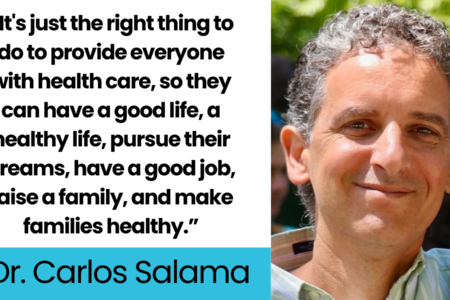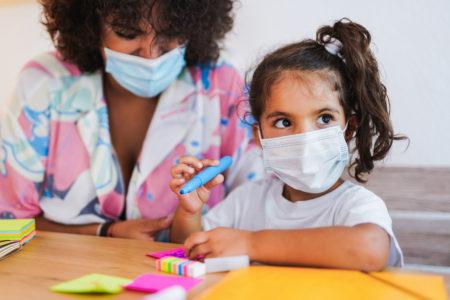
Share On Social!
Source control keeps germs from spreading by stopping them at their source before they can spread to other people.
Source control is an important tool to reduce the spread of COVID-19 and other respiratory infections in the healthcare setting.
For COVID-19, source control focuses on covering your nose and mouth with a mask to keep your respiratory droplets out of the air.
Masking applies to Latinos and any person with or without symptoms, because anyone infected with SARS-CoV-2 can be asymptomatic. This means they are not showing symptoms and may not be aware that they have the virus.
In this case, even if they are asymptomatic, they can still spread the virus to others through respiratory droplets they make when talking, breathing, singing, sneezing, or coughing.
“Masks that fit snugly around the cheeks and our chin are the main way to do source control for COVID-19,” said Dr. Abigail Carlson, an infectious diseases physician with the Centers for Disease Control & Prevention (CDC), as part of CDC Project Firstline’s Inside Infection Control video series.
Wearing a Mask for Source Control
Your mask should fit well, without gaps at the edges, and cover your nose and mouth.
This snug fit can block respiratory droplets that are released into the air when you breathe, speak, cough, or sneeze.
If you are caring for a patient with COVID-19 and you are using an N95 respirator, you are protected from the virus that your patient is breathing out, and your patients and colleagues are protected from germs that you might be breathe out.
“All of this source control is important for COVID-19 because we don’t always know who’s infected,” Dr. Carlson said.
What Can You Do to Promote Infection Control in Your Healthcare Setting?
Access more information about infection prevention and control in healthcare by visiting resources from CDC Project Firstline.
Project Firstline creates resources, including videos and shareable images, web buttons, posters, and print materials. They also have facilitator toolkits to help workers lead trainings even if they are not an infection control expert.
Salud America! at UT Health San Antonio is working with the National Hispanic Medical Association to bring Project Firstline infection control educational content to healthcare workers, so they are equipped with the knowledge they need to protect themselves, their facilities, and their patients (Latinos and all communities) from infectious disease threats in healthcare settings.
You can read these articles:
- What is Project Firstline?
- What’s a Virus?
- How Do Viruses Make Us Sick?
- What is Ventilation and Why Does It Matter?
- How Does Infection Control Work on COVID-19 Variants Like Omicron?
- Contact Time: What is It and How Does it Impact Infection Control?
- The Surprising Difference Between Cleaning and Disinfection
- What’s a Respiratory Droplet and Why Does It Matter?
- Why Do Cleaning and Disinfection Matter in Healthcare?
- We Need to Talk about Hand Hygiene Again
- What is the Goal of Infection Prevention and Control in Healthcare Settings?
- The Intersection of Infection Prevention and Control and Healthcare Equity
- N95 Respirators: Everything You Need to Know
- How Do I Safely Use a Multi-Dose Vaccine Vial?
- Why are Gowns, Gloves, and Eye Protection Recommended for COVID-19?
“Healthcare teams in hospitals, nursing homes, and other care settings are the front lines against the spread of infection,” said Dr. Amelie G. Ramirez, director of Salud America! at UT Health San Antonio. “CDC’s Project Firstline is bolstering those efforts by developing evidence-based tools that can be delivered in a variety of ways to make infection control learning convenient and accessible for busy healthcare staff.”
LEARN MORE ABOUT PROJECT FIRSTLINE!
Editor’s Note: This article is part of a collaboration between Salud America!, the National Hispanic Medical Association, and the CDC’s Project Firstline. To find resources training materials, and other tools to bolster knowledge and practice of infection control, visit Project Firstline and view Salud America!’s infection control content.
Explore More:
Infection ControlBy The Numbers
142
Percent
Expected rise in Latino cancer cases in coming years




[…] The pandemic is another chapter in the bitter story of American racism and inequality. Black and Latinx people are being infected and are dying at much higher rates than white Americans. Many people of […]
[…] coronavirus has killed over 61,000 Latinos in America according to the CDC, accounting for over 18.2% of the total COVID deaths in the […]
[…] Whereas Hispanics make up 11% of D.C.’s inhabitants, they signify 19% of the COVID cases, and 14% of the deaths. Equally, 46% of D.C.’s residents are Black, they usually make up an alarming 75% […]
[…] and historical mistreatment. According to the U.S. Centers for Disease Control and Prevention, Latino and Black American communities are three times more likely to become infected with […]
[…] Covid pandemic has hit the Latino community particularly hard, and data from the nonprofit health equity advocacy group Salud America! shows Latinos lead in the 0-24 age […]
[…] the pandemic, Latinos took major blows, both in terms of COVID-19 cases and also from the economic recession under former President Donald Trump. Nearly half (49%) of […]
[…] the positive trend, the harm may have already been done. The pandemic has disproportionately impacted Latino communities. Reuters reported that election-related or political disinformation that […]
[…] pesar de la tendencia positiva, es posible que el daño ya esté hecho. La pandemia ha impactado desproporcionadamente Comunidades latinas. Reuters informó que la desinformación política o relacionada con las […]
[…] residentes blancos muestran una tasa mucho más baja con 10 muertes por cada 100,000 habitantes(8 9) . Los afroestadounidenses por su parte, denuncian subsistemas de salud que les segregan […]
[…] https://salud-america.org/coronavirus-case-rates-and-death-rates-for-latinos-in-the-united-states/ […]
[…] https://salud-america.org/coronavirus-case-rates-and-death-rates-for-latinos-in-the-united-states/ […]
[…] communities have the second-highest number of COVID-19 cases in the U.S. They’re also more likely to become hospitalized and die from the disease than other […]
[…] total, around 160,000 Latinos were killed by COVID-19. This accounts for 16% of the 1 million deaths in the country. The […]